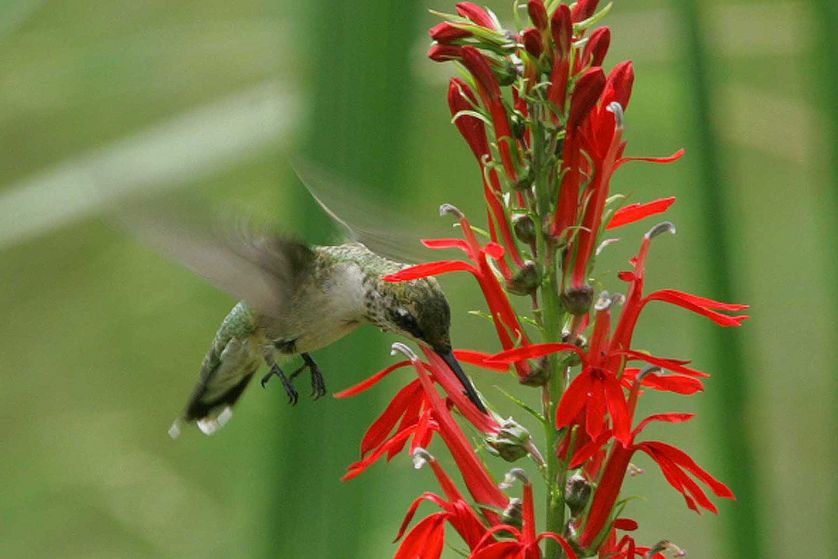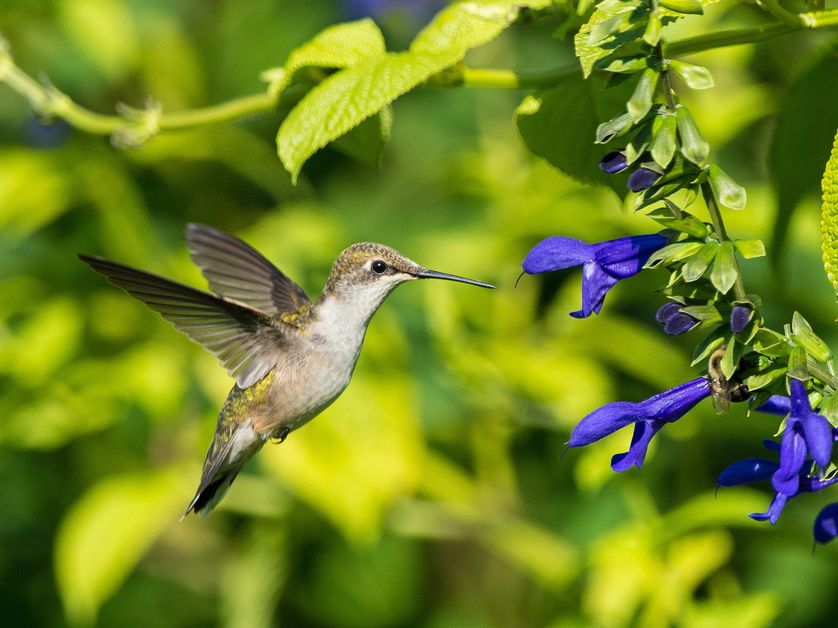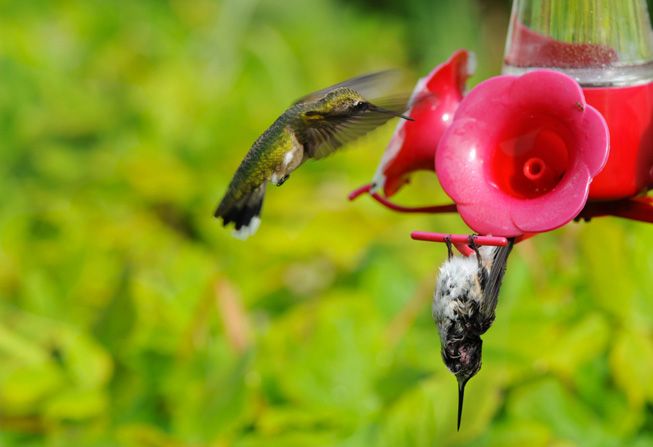Source: mnn.com
Published: May 10, 2012
Feeders work, but creating a native plant habitat is more effective.

Contrary to popular opinion, flowers don’t have to be red to attract hummingbirds. (Photo: Charles Brutlag/Shutterstock)
Gardeners, it seems, are competitive people who like to have the first of almost anything.
Some will race to nurseries to be the first to own the newest hybrid.
Others are determined to harvest the first ripe tomato of summer.
And a growing number, based on the proliferation of tubular feeders with red bases and yellow flowers in nursery displays, are making a sport of attracting the first hummingbird of spring to their yard.
There’s another way to attract hummingbirds. Plant a hummingbird habitat.
What is a hummingbird habitat?
A hummingbird habitat consists of flowers, shrubs and trees that produce nectar and, ideally, a mist-type water feature. Nectar is a liquid rich in sugar that attracts various pollinators, such as bees, moths and hummingbirds. A hummingbird habitat is different from a garden because a habitat provides a place for the tiny birds to feed, hide from predators, nest and raise their young, according to Bill Hilton Jr.
Hilton says he has banded about 4,500 hummingbirds in York, S.C., since he started Operation RubyThroat: The Hummingbird Project in 1984. This nonprofit venture promotes study of the ruby-throated hummingbird (Archilochus colubris) throughout the species’ summer breeding range in North America. That range includes 38 states east of the Great Plains and extends into Canada across the southern provinces from Alberta to British Columbia and as far north as Nova Scotia.
Hilton is also the only scientist studying ruby-throat behavior on the species’ wintering grounds in Central America, where he’s banded another 1,000 individuals. Ruby-throats have the greatest summer-winter range of any hummingbird species and are the only hummer species that breeds east of the Great Plains, according to Hilton.
How do I know if a plant produces nectar?
One way is to observe the plants already in your yard to see what birds or insects are visiting them, Hilton said. You can also check with local extension services or nurseries or research plants online.
Are some plants especially attractive to hummingbirds?

Hummingbirds are drawn to the nectar of the cardinal flower. (Photo: Bill Buchanan/USFWS/flickr)
Yes. Based on decades of research and observation, Hilton has compiled a list of what he considers 10 of the ruby-throated hummingbird’s favorite native flowers, shrubs and vines that grow in its North American breeding range.
Here’s Hilton’s list, ranked in order of preference:
- Trumpet creeper, Campsis radicans
- Beebalm or Oswego tea, Monarda didyma
- Trumpet honeysuckle, Lonicera sempervirens
- Cardinal flower, Lobelia cardinalis
- Spotted jewelweed, Impatiens capensis
- Red columbine, Aquilegia canadense
- Canada lily, Lilium canadense
- Indian pink, Spigelia marilandica
- Red buckeye, Aesculus pavia
- Mountain rosebay or Catawba rhododendron, Rhododendron catawbiense
One of the reasons these plants made his list rather than others is because many of them grow in almost all of the states where the ruby-throat breeds, Hilton says. He cited trumpet creeper as an example.
Other native plants that provide flowers for hummingbirds may already be growing in your yard, including tulip poplars (Liriodendron tulipifera) and sourwood (Oxydendrum arboreum), he added.

A hummingbird finds nectar in some blue sage. (Photo: DC Gardens/flickr)
Hilton has also compiled a top 10 list of exotics plants, not all of which are cold-hardy, that attract hummingbirds.
Here’s his list of exotics, ranked in order of preference:
- Pineapple sage, Salvia elegans
- Giant blue sage, Salvia guaranitica
- Cypress vine, Ipomoea quamoclit
- Shrimp plant, Justicia brandegeana
- Mimosa, or silktree, Albizia julibrissin
- Shrub verbena, Lantana camara
- Butterfly bush, Buddleja davidii. also spelled Buddleia
- Rose of Sharon, Hibiscus syriacus
- Common foxglove, Digitalis purpurea
- Cigar plant, Cuphea ignea
Some of these plants, such as giant blue sage and butterfly bush, are popular landscape plants and readily available in nurseries and the garden section of box stores.
Because producing nectar requires a lot of energy and plants get that energy from the sun, plants that attract hummingbirds typically do not do well in shady areas. These are not forest birds, Hilton points out.
To attract Western hummingbirds, such as the rufous hummingbird or Anna’s hummingbird, Hilton suggests using local flowering plants, especially natives, that have a strong nectar load. He encourages West Coast gardeners to be careful about what they plant because plants not native to the region could become invasive in some of the ideal growing conditions there.
Don’t hummingbirds feed only on red tubular flowers?
Not at all, says Hilton. They are very opportunistic feeders. As long as a flower has nectar, it doesn’t have to be tubular or red. He pointed out Japanese azaleas as an example of plants with red tubular flowers that don’t have nectar and thus are not a source of food or interest to hummingbirds.
Hummingbirds are a gardener’s friend, Hilton said, because they feed on insects such as gnats, mosquitoes and aphids, which provide fats and protein. Sometimes they glean the insects from bark or foliage and other times they will dart to and from a perch to feast on a cloud of gnats.
Can I still hang out a hummingbird feeder?
Of course. The time to do that is roughly from St. Patrick’s Day to Halloween, Hilton said.
He describes the ruby-throat as a cold-weather wimp. Using Atlanta as a yardstick for the East Coast, he says the birds usually will not show up in the South’s largest metro region until St. Patrick’s Day and will generally have left for their winter home in Central America by the end of October. Hummingbird enthusiasts south of Atlanta can plan on the birds showing up a little earlier than St. Patrick’s Day and those further up the East Coast can add a week or more depending on their location.

The best time to hang a hummingbird feeder is mid-March through the end of October. (Photo: Bill Staney/flickr)
The ratio of water to sugar for feeders is 4:1. That’s 20 percent, which is about the percent of sugar in the nectar of most nectar-bearing flowers, Hilton said. Feeders should be emptied and filled with a fresh solution twice a week in hot weather and once a week in spring and fall. He encourages people not to use red food coloring in the solution, which he said is not necessary because the additive could be harmful to the birds, although he concedes this has not been proven.
Feeders can be left up all winter if the Western hummingbirds have shown up as variants. And, in the last 10 years observers have even seen a few ruby-throats overwintering in coastal and inland areas in the Southeast. Hilton says he banded nine ruby-throats on North Carolina’s Outer Banks in January, and an observer in Tennessee has seen one there during a recent winter.
Anyone who leaves a feeder up throughout the winter should refresh the food weekly, Hilton advised. He added that leaving the feeder up will not cause birds to stay in cold winter areas instead of migrating. They are photo-period sensitive he said, which means as day length changes, the birds know it’s time to migrate.
For those few that don’t, he said, there are enough tiny flying insects for them to feed on to give them sufficient fats and proteins to make it through the winter.
Having a winter feeder up would also put you in line to be the first one in your area to have a hummingbird in your yard next spring! Tom Oder
